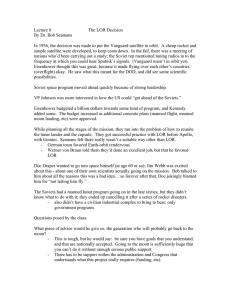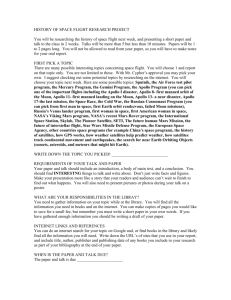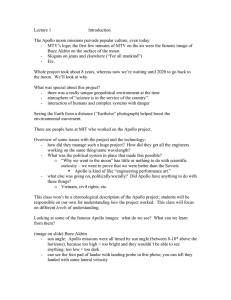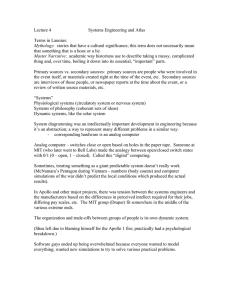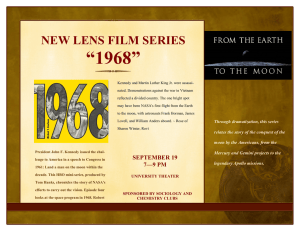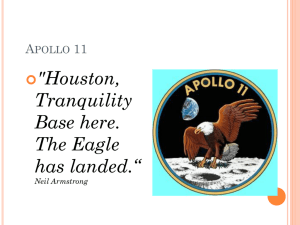Lecture 15 “Key Decisions in the Apollo Program” by John Logsdon
advertisement
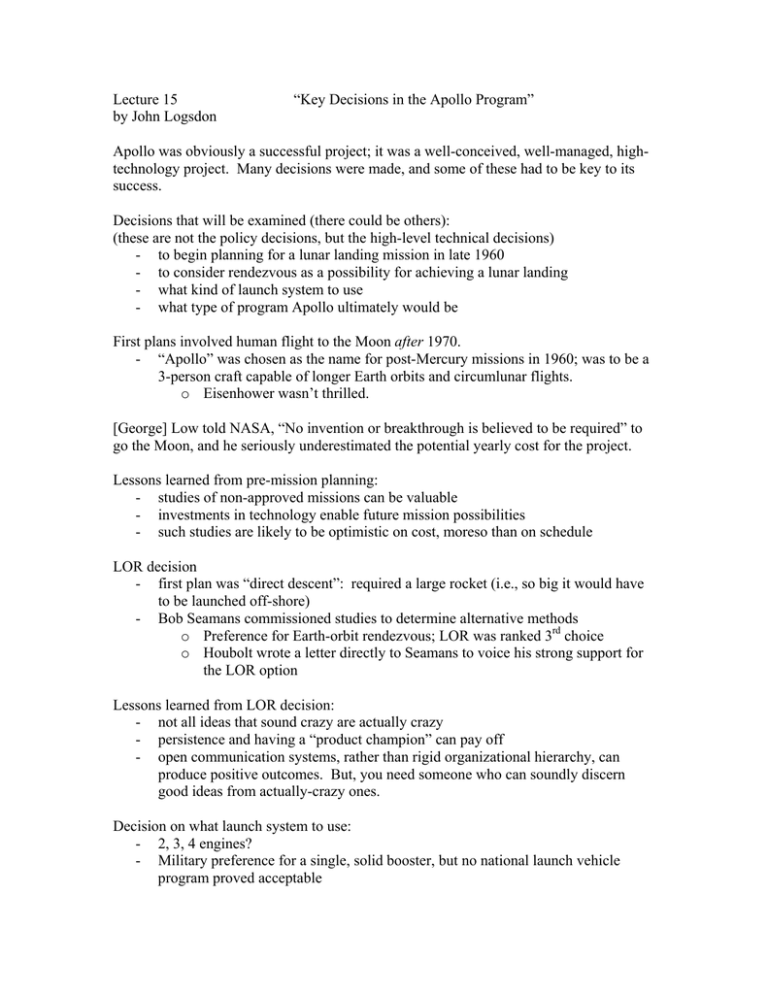
Lecture 15 by John Logsdon “Key Decisions in the Apollo Program” Apollo was obviously a successful project; it was a well-conceived, well-managed, hightechnology project. Many decisions were made, and some of these had to be key to its success. Decisions that will be examined (there could be others): (these are not the policy decisions, but the high-level technical decisions) - to begin planning for a lunar landing mission in late 1960 - to consider rendezvous as a possibility for achieving a lunar landing - what kind of launch system to use - what type of program Apollo ultimately would be First plans involved human flight to the Moon after 1970. - “Apollo” was chosen as the name for post-Mercury missions in 1960; was to be a 3-person craft capable of longer Earth orbits and circumlunar flights. o Eisenhower wasn’t thrilled. [George] Low told NASA, “No invention or breakthrough is believed to be required” to go the Moon, and he seriously underestimated the potential yearly cost for the project. Lessons learned from pre-mission planning: - studies of non-approved missions can be valuable - investments in technology enable future mission possibilities - such studies are likely to be optimistic on cost, moreso than on schedule LOR decision - first plan was “direct descent”: required a large rocket (i.e., so big it would have to be launched off-shore) - Bob Seamans commissioned studies to determine alternative methods o Preference for Earth-orbit rendezvous; LOR was ranked 3rd choice o Houbolt wrote a letter directly to Seamans to voice his strong support for the LOR option Lessons learned from LOR decision: - not all ideas that sound crazy are actually crazy - persistence and having a “product champion” can pay off - open communication systems, rather than rigid organizational hierarchy, can produce positive outcomes. But, you need someone who can soundly discern good ideas from actually-crazy ones. Decision on what launch system to use: - 2, 3, 4 engines? - Military preference for a single, solid booster, but no national launch vehicle program proved acceptable - LOR emerging as probable strategy; would affect which launch system was chosen. Had to make a final decision about LOR, though. Von Braun suggested 5 engines in the first stage, 4 in the second, and 1 in the third. Lessons learned: - designing a single family of vehicles for all projects is really unlikely - careful systems analysis is required for any particular mission, as to what kind of launch capabilities are required - don’t get married to a particular launch vehicle too early in the project. As project developments, launch requirements will undoubtedly be modified. LOR final decision: - 1961, new leadership at NASA (Holmes and Shea). They were committed to making Apollo successful, and were not committed to the ideas that had become entrenched early on in planning; they gave more serious attention to LOR (with prompting from Houbolt). Lessons learned: - well-performed, honest analysis can modify pre-existing preferences - deadlines have a limiting impact on choices, which may have negative long-term consequences o LOR with Saturn V was a good way of getting to the moon pre-1970, but had limited extended use. Resisting the decision to make Apollo a crash program: - Holmes wanted to accelerate Apollo, and challenged Webb’s authority to run the civilian space program. Leaked his views to Time magazine; suggested that Webb was an obstacle to getting to the moon as quickly as possible. - Webb felt that the program should proceed at a balanced pace, and recognized that getting the moon was not NASA’s only goal; they wanted to be pre-eminent in all areas of space exploration. Kennedy’s interest was not so much in space, as in beating the USSR to the moon. - Webb made a strong argument to Kennedy that accelerating the program was a bad idea. - Ultimately, Webb won the power struggle. Lessons learned: - skilled agency leadership is required to resist external and internal pressures and conflicts - There is probably an optimum technical pace for a major development program - Preserving program balance is important both technically and politically, in the long-term Sending Apollo 8 to the Moon - Apollo craft redesigned after the 1967 fire - LM running behind schedule; threatened to delay flight by several months, would possibly put the landing by1969 goal at risk Soviets were running tests for circumlunar flight at this time A few technically competent people made the decision to send Apollo 8 to the moon in one day Lessons learned: - bold ideas can produce high payoffs - shared leadership is essential - personalities have a lot of influence - risks.. Second lecture: Exploration Architecture Update (originally prepared Feb 7, 2007, by Doug Cooke, Deputy Associate Admin, NASA Exploration Systems Mission Directorate) Merits of a lunar outpost: economic; as preparation for future exploration on Mars; provides a sustainable location for different projects and objectives; provides opportunities for international collaboration; and more. - outpost would be located at a pole (thermally more stable; permanently or almost permanently illuminated; cold dark craters are interesting; etc.) Vehicle for getting there is still under design U.S./NASA will design and build the transportation infrastructure and initial communication, navigation, and initial EVA, but they’re open to commercial and international contributions. In fact, of all the things that need development, they’re only committed to building a short list; the rest is open for bids. It’s a necessity, in fact; there is not enough money in NASA to cover all of it. This decision hasn’t actually been made yet, of course; the U.S. government hasn’t made the decision to allocate the funds. These plans are being made in anticipation of a project that will take 10-15 years, so this is a very early stage of a very long-term endeavor.
